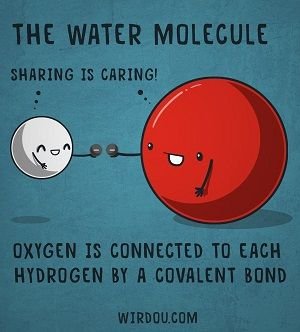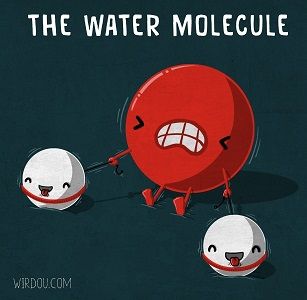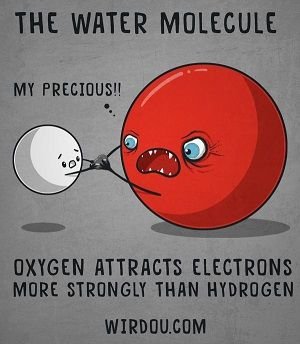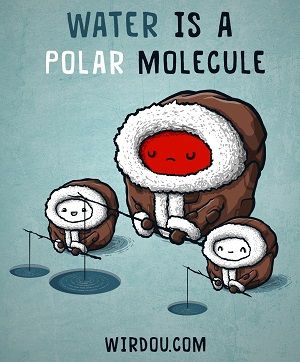Science for Everybody #6: The microwave oven / Wissenschaft im Alltag #6: Der Mikrowellenherd

Hello Steemians,
to understand the following article, it would be helpful to have some basic knowledge about atoms and compounds and temperature. If you are unsure, you can read the corresponding articles.
Today’s topic
This posting is about a tool that many of us are probably using. Perhaps, some of you have thought about why or how it is working: the microwave oven. Today, we will look at the physical-chemical principles behind this little electronic kitchen help.
Microwaves
Microwaves are, like e.g. x-rays, light and radio waves, part of the so-called electromagnetic spectrum. Their wavelength is between infrared radiation and radio waves and that is why they have rather low energy.
Generating microwaves
The microwaves are generated in a so-called magnetron. This is a quite complex device that works with high voltage and a magnetic field at the same time. Besides the desired microwaves, it produces heat which we can feel during operation on the side or back of the microwave oven.
Leading to the cooking chamber
The microwaves are led from the magnetron to the main chamber of the oven with the help of a waveguide. Basically, this is a round, oval or rectangular pipe which conducts the microwaves like a cable conducts current. The cooking chamber itself is magnetically shielded everywhere with metal and the door has a metal foil that reflects the microwaves. The holes in the foil on the door allow to view inside the oven, but they are smaller than the wavelength of the microwaves and that is why the reflection still works. However, it is important to operate the oven not with an empty chamber because otherwise, part of the energy can be reflected to the magnetron and possibly causes damage.
Microwave and food
How do the microwaves manage to warm our food? Somehow the transported energy seems to be absorbed and converted to heat. To get to know this better, we need to look at how our food is built. An important molecule that is in every food is the water.
The water molecule
Composition of the molecule
Chemically, water can be divided into two components: the two non-metals hydrogen and oxygen in a ratio of 2:1. We already know (or can look up above) that two non-metals are bonded together by adding their electrons to pairs of two each and divide them in a way that every atom has 8 electrons (meaning 4 pairs) then. A little exception from this rule are the elements hydrogen and helium – they have only one shell and therefore they are happy with 2 electrons.

If we take a closer look on the buildup of the atoms, we notice that each hydrogen atom wants to have one bond and each oxygen atom two bonds. Thus, oxygen sits in the middle and is bonded to a hydrogen on two sides.
Structure of the water molecule
The compound consisting of our three atoms is – if we look at it in a three-dimensional way – not a rot with three balls on it but angulated. So, the two hydrogen atoms are tilted towards each other and a triangular shape is formed. (The explanation for this needs a bit more depth in the theory of chemical bonding and therefore will not be part of this article.)

The elements have another important property: the electronegativity. This value gives us an idea, how the elements attract electrons in a bond towards themselves. Thus meaning, the elements are up to share their electrons in general but in secret, they want just a little bit larger slice of the cake – just like it is with some human beings (we know from metals that they want to give their electrons away and so they have a small electronegativity – in this case, we talk sometimes about a (high) electropositivity).

The electronegativity of oxygen is higher than that of hydrogen. That is why the electrons are over time more often located near one of the edges of the triangle rather than on the two other edges with the hydrogen atoms. Therefore, the oxygen-edge is charged a little bit more negative and the hydrogen-edges a little bit more positive. Because there is no real charge (which would only arise if electrons are permanently shifted), we call it a partial charge. It arises from the asymmetric distribution of the electrons over time due to their movement. Thus, the water molecule has two contrary charged sides and it is called a dipole-molecule. Generally, it behaves like a tiny magnet. Some specific characteristics result from this property but we will look at them in another article.

Effect of the microwaves
So, what has the dipole-property of water to do with our microwaves? As we have seen, microwaves are electromagnetic waves and therefore they influence other electrically charged particles. The water has no real charge indeed, but the two different sides are enough to make it show some interest for the microwaves: it is trying to orientate to the electric field. However, the field is permanently changing because waves have peaks and hollows. Therefore, the water molecule has to flip all the time and begins to dither more and more. If you remember, what temperature actually is, you will notice, that we have more movement because of the permanent flipping and so we reach higher temperature. So, we have a contactless heating which works the better, the more water is present in the food. And that is why the vessels like bowls and plates are not heated directly but after they extract some warmth from the food.
Terminating for now
I hope that I was able to explain you the function of a microwave oven and you know now, why noodles, for example, heat up faster, if you splash some water on them first. By the way, popcorn for microwave ovens has not so much water and you need higher temperatures. Therefore, the packaging has a special foil in it, which absorbs microwaves excellently and reaches high temperatures upon heating.
See you next time!
Source of the cartoons: https://wirdou.com/
Hallo Steemianer,
um den heutigen Artikel vollständig zu verstehen, wäre es gut, wenn euch die Grundlagen über Atome und Verbindungen und über Temperatur halbwegs geläufig wären. Lest im Zweifelsfall nochmal in den entsprechenden Beiträgen nach.
Heutiges Thema
Das Thema des Tages dreht sich um ein Gerät, das viele von uns vermutlich benutzen. Vielleicht hat sich auch schon der ein oder andere Gedanken gemacht, warum bzw. wie es funktioniert: Es geht um den Mikrowellenherd. Wir wollen uns die physikalisch-chemischen Prinzipien hinter diesem Alltagshelfer mal genauer anschauen.
Mikrowellen
Mikrowellen sind, genau wie z.B. Röntgenstrahlung, Licht und Radiowellen, Teil des sogenannten elektromagnetischen Spektrums. Sie liegen von ihrer Wellenlänge zwischen der Infrarotstrahlung und den Radiowellen und haben daher relativ wenig Energie.
Erzeugung der Mikrowellen
Die Mikrowellen werden in einem sogenannten Magnetron erzeugt. Das ist ein recht komplexes Bauteil, das mit Hochspannung und gleichzeitig einem Magnetfeld arbeitet und dabei neben den Mikrowellen auch einiges an Wärme produziert, die man im Betrieb meistens an der Seite oder Rückwand des Mikrowellenherdes fühlen kann.
Einleitung in den Garraum
Die Mikrowellen aus dem Magnetron werden mit einem Hohlleiter in die Hauptkammer des Herdes geleitet. Dabei handelt es sich im Prinzip um ein rundes, rechteckiges oder ovales Rohr, in dem die Mikrowellen weitergeleitet werden, ähnlich wie ein Kabel elektrischen Strom leitet. Der Garraum selbst ist überall magnetisch mit Metall abgeschirmt und die Tür mit einer Metallfolie versehen, wodurch die Mikrowellen reflektiert werden. Die Löcher in der Folie an der Tür dienen dazu, den Innenraum zu sehen, sind aber kleiner als die Wellenlänge der Mikrowellen, weshalb die Reflektion trotzdem funktioniert. Es ist daher wichtig, Mikrowellen nicht leer zu betreiben, da sonst ein Teil der Energie in das Magnetron zurück reflektiert werden kann und dort eventuell Schaden anrichtet.
Mikrowellen und das Essen
Wie schaffen es die Mikrowellen nun, unser Essen zu erwärmen? Irgendwie wird die durch sie transportierte Energie offenbar absorbiert und in Wärme umgewandelt. Um dies genauer zu verstehen, müssen wir uns anschauen, wie unser Essen aufgebaut ist. Ein zentrales Molekül, das in jedem Essen vorhanden ist, ist das Wasser.
Das Wassermolekül
Aufbau des Moleküls
Chemisch kann man Wasser in zwei Bestandteile zerlegen: Die beiden nichtmetallischen Elemente Wasserstoff und Sauerstoff, wobei sich ein Verhältnis von 2:1 findet. Wie wir wissen (oder oben nachlesen können), verbinden sich zwei Nichtmetalle, in dem sie ihre Elektronen in Paaren zu je zwei Stück zusammentun und diese so teilen, dass jeder hinterher 8 Elektronen (bzw. 4 Paare) hat. Eine kleine Ausnahme sind hierbei die Elemente Wasserstoff und Helium – sie haben nur eine Schale und sind deshalb mit 2 Elektronen zufrieden.

Wenn man sich den Aufbau der Atome etwas genau anschaut, stellt man fest, dass jedes Wasserstoffatom eine Bindung und jedes Sauerstoffatom zwei Bindungen haben möchte. Damit ergibt sich, dass der Sauerstoff in der Mitte sitzt und an zwei Seiten mit einem Wasserstoff verbunden ist.
Gestalt des Wassermoleküls
Die Verbindung aus unseren drei Atomen sieht dreidimensional betrachtet nicht aus, wie ein Stäbchen mit drei Kugeln, sondern sie ist gewinkelt und die beiden Wasserstoffatome zueinander gekippt, sodass sich eine dreieckige Form ergibt. (Die Erklärung hierfür erfordert etwas mehr Tiefe in der Theorie chemischer Bindung und soll daher hier nicht Gegenstand sein.)

Elemente haben eine weitere, für uns wichtige, Eigenschaft: Die Elektronegativität. Diese Größe gibt an, wie stark ein Element Elektronen in einer Bindung zu sich zieht. Das bedeutet, im Prinzip sind die Elemente zwar bereit, zu teilen, aber insgeheim wollen sie doch etwas mehr vom Kuchen haben – ganz wie es bei einigen Menschen auch der Fall ist (von Metallen wissen wir ja z.B., dass sie ihre Elektronen gerne abgeben, daher haben sie auch eine sehr kleine Elektronegativität – man spricht dann auch manchmal von (hoher) Elektropositivität).

Da die Elektronegativität von Sauerstoff höher ist als von Wasserstoff halten sich die Elektronen über die Zeit etwas häufiger in der Nähe der einen Dreiecksspitze auf, als bei den beiden anderen Spitzen, in denen die Wasserstoffatome sitzen. Damit ist die Sauerstoff-Spitze etwas negativer geladen und die Wasserstoff-Spitzen etwas positiver. Da es sich nicht um eine echte Ladung handelt, die nur entsteht, wenn Elektronen dauerhaft verschoben werden, spricht man von Teilladung oder Partialladung, die durch zeitliche Aufenthaltswahrscheinlichkeit bei der Bewegung von Elektronen entsteht. Da das Wasser also zwei entgegengesetzt geladene Stellen hat, spricht man auch von einem Dipol-Molekül. Es ist im Prinzip nichts anderes, als ein winzig kleiner Magnet. Einige Besonderheiten des Wassers resultieren aus dieser Eigenschaft, doch das werden wir uns ein anderes Mal anschauen.

Wirkung der Mikrowellen
Was hat das Dipol-Dasein des Wassers nun mit unseren Mikrowellen zu tun? Die Mikrowellen sind wie gesagt, elektromagnetische Wellen und damit beeinflussen sie auch elektrisch geladene Teilchen. Unser Wasser trägt zwar keine echten Ladungen, aber die beiden unterschiedlichen Seiten reichen doch aus, damit es sich für die Mikrowellen interessiert: Es versucht sich, nach deren Feld auszurichten. Das Feld der Mikrowellen wechselt jedoch ständig – Wellen haben immer Täler und Berge. Daher muss sich das Wassermolekül ständig umdrehen und fängt an, immer mehr zu zappeln.
Wenn ihr euch jetzt noch erinnert, was Temperatur eigentlich ist, stellt ihr fest, dass wir durch das Hin- und Herdrehen unserer Wassermoleküle eben genau mehr Bewegung und damit höhere Temperaturen erreichen. Wir haben also eine kontaktlose, indirekte Heizung, die umso besser funktioniert, je mehr Wasser im Essen vorhanden ist. Und deshalb erwärmen sich auch die Gefäße wie Schüssel und Teller erstmal nicht direkt, sondern erst, indem sie dem Essen die Wärme wieder teilweise entziehen.
Zum Abschluss
Ich hoffe, ich konnte euch erklären, wie eine Mikrowelle funktioniert und ihr wisst jetzt, warum beispielsweise Nudeln schneller warm werden, wenn man sie vorher etwas mit Wasser bespritzt. In Mikrowellen-Popcorn ist übrigens nicht so viel Wasser und man braucht auch höhere Temperaturen, dafür ist in der Packung eine spezielle Folie, die die Mikrowellen gut absorbiert und sich stark erhitzt.
Bis zum nächsten Mal!
Quelle der Cartoons: https://wirdou.com/
Nice article! Considering the cartoons of the water molecule, I now have the idea in mind that the oxygen dances and flips around with his two hydrogen friends, going fastet and faster... while the microwaves are like the music that they are dancing to... :)
Thank you! And thanks for putting this image in my mind too :-P I hope, the don't lose contact while dancing and fly through the hole space... ;-)
I hope you dance as well being happy that your first comment ever brought you already 4 dollar. :-)